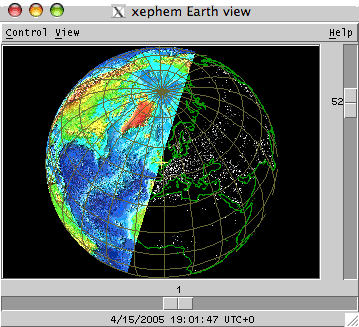April 17th, 2005

The bodmas site is now being run through WordPress 1.5 with a few additions…
- Default Kubrick theme has been munged to remove images and to present post text as right ragged instead of justified
- The Kubrick theme uses excerpts to generate archive and category pages – I have changed this to full post content
- The Custom Query String Plugin by Matt Read allows different numbers of posts on different kinds of ‘page’ – pages in WordPress being queries on a database.
- I’m currently using 3 posts on the home page, 15 on each monthly archive page and unlimited on the category archive pages
- The next part of the master plan is to see if I can use nice URLs instead of showing the actual database query string in the browser address bar…
Posted in Notes | Comments Off
April 15th, 2005

Xephem is a Unix/Mac OS X based sky chart and ephemeris program. The program costs $80 for a precompiled version on CD-Rs or by download along with a huge set of catalogues and the Lunar Orbiter images. An identical version is available for download only at $60. This is a 1 Gb download spread over three gzip files. I have downloaded just Cd 1 to get the basics running on my iBook, the Lunar Orbiter photos and large field star catalogues will wait until the CDs arrive.
You can download the source for free and build your own version of the application and then download the catalogues from various astronomicl servers for nowt. Youngsters with access to a broadband connection but limited cash could build their own version and learn about compiling code. You can compile a Windows version under the Cygwin environment but I can think of better things to do on a wet Sunday. The excellent free Cartes Du Ciel might be a better bet for Windows.
Xephem runs under X11 on Mac OS X, and the interface needs some working out – it is nothing like the Mac OS native applications. I’m hacking my way into it – mainly because the program produces excellent PostScript star charts and I can use Preview to pop those into Word (at screen resolution) or incorporate them into TeX documents. The PS files are produced by ‘printing to a file’ from xephem’s print menu and the single page files load directly into my ancient copy of Adobe illustrator. The page size appears to be fixed at either Letter or A4. I’m sure there will be a way of getting A3 charts.
In Mac OS X Preview I can also Copy a part of the PS file and Paste as New and then save the region as a PDF file. A challenge – can you recognise this field (PDF, 60Kb)?
The package can fetch data from Web based astronomical databases – including a light curve lookup feature from the AAVSO Web site.
Posted in Notes | Comments Off
April 15th, 2005

- Free sound editor available for download
- Versions for Linux, Mac OS X and Windows
- Can edit MP3s and .wav formats
- Can record from microphone or other sources supported by the computer
- Supports a sound programming language called Nyquist
- Possibly the best icon I have seen for an open source program – wouldn’t mind getting the T-shirt!
- I have this idea of putting sound tracks on kiosk based MS PowerPoint demonstrations – we shall see
Posted in ILT | Comments Off
April 13th, 2005
Ellen Lupton’s book Thinking With Type is supported by a useful and thought provoking Web site. A table links to short pages of information on various concepts to do with typography and page layout, mainly for printed pages. The table columns move along a logical sequence of scales (Letter – Text – Grid). There is a lesson activity for design teachers to download and use.
- One page contains a flash animation that shows horrible things being done to characters.
- Another page has a series of aphorisms relating to design. Alas, one of the wise sayings is “Make the shoe fit, not the foot”, and, yes this is on a page with a fixed width table based layout. The page has the title Dumb Quotes so perhaps the joke is on me afterall
Posted in Web | Comments Off
April 9th, 2005
The Centre for Innovation in Maths Teaching based at the University of Exeter provides a range of materials for free download on their Web pages. In particular, there is the Mathematics Enhancement Programme for key stage 4 that provides GCSE maths materials as PDF downloads. There are 20 units available, and the units are provided with four differentiated pathways in the form of ‘practice’ books. Password protected answer books are available, as are downloadable OHP foils with lesson starter activities.
Never one to look to closely at the dentition of an equine philanthopist, I shall be printing out the units and seeing if adult students find them useful as extra reference material and homework.
Posted in Maths | Comments Off
April 6th, 2005
The Business School hack has highlighted issues of definition around access to information. The (US based) article in The Register by Mark Rasch reports the facts as follows…
- Some US business schools farm out processing of Web based applications to a third party Web company
- Someone identified a security hole in the system used to process the applications that allows access to personal details without passwords (modified URL - a scripting error
- This person (handle: ‘Brookbond’) posts details of the hack and a helpful script on a forum that applicants might be expected to read
- 119 applicants use the hack to check the progress of their applications
- The Web server logs contain details of who peeked
- different Business Schools adopt different standards when dealing with the applicants – ranging from disqualification to review on a case by case basis
- The Web services company makes no comment about the exploit in public
Rasch runs through the US laws (less relevant to UK) and then goes on to discuss the ethical aspects of the activities of the various actors. He contrasts physical trespass (nice hotel analogy) with cyberspace tresspass.
“The ordinary rules of behavior tend not to apply in cyberspace. For some reason, because we are merely sitting at a computer screen in our own den just typing, we aren’t doing anything “wrong” or criminal. There is a huge tendency to blame the victim – if they didn’t WANT me to break in, why didn’t they have better security?”
I’ll be using a role play based on this example in the Forensic ICT unit…
Posted in Forensic | Comments Off
April 5th, 2005
“Teddys would be with their user for their entire lives. They would change in shape and form to match the growing sophistication and interests of the person, but each time someone got a new model Teddy, the information from the earlier version would be transferred to the new. As a result, Teddy would always retain a complete record of all the person’s personal experiences and knowledge for an entire lifetime even as it changed in physical form.”
“Eventually, as people came to rely upon their Teddys, they would reach a point where they would be disoriented without them. After all, with a Teddy, you would never be alone. You could always talk to Teddy. It would never desert its owner. It could be programmed to give reassurances, to follow progress on a task and to make appropriate suggestions. It could serve as a continual reminder of names and dates: time to do exercise, to phone home, buy gifts, etc. “
From Don Norman’s The Teddy, originally Chapter 6 of Turn Signals are the facial expressions of automobiles (wondeful title but the book failed to sell and is now out of print).
Personally I suspect my electronic Teddy would get left on the beach sometime around when I was 5, like my stuffed fur one did. The phrase “You could always talk to Teddy” raises visions of Microsoft Councillor Version 6.5 and so on….. uggh. There are some saving graces to the hideously poor ‘glass teletype with pointer’ computer interfaces we have at present!
Posted in Forensic, ILT | Comments Off


